By Karin Miller, Owner/Founder Zen Tenkara/Zen Fly Fishing Gear

When people hear mention of tenkara, they typically think of small streams and creek fishing for fish in similar size categories. Most anglers would not consider using a tenkara rod for a float trip, but I encourage you to continue reading. By the end of this article, you might consider otherwise.
Tenkara, if you’re not familiar, is the Japanese method of fixed-line fly fishing. Tenkara rods are ultralight, collapsable, have no guides, and use no reel. The rods come in different lengths but traditionally are long. A 12ft tenkara rod is quite common, but they can be as short as 7ft or as long as 15ft.
This method of fly fishing first hit the United States in 2009. Since then, tenkara fishing has slowly but gradually become more popular. Tenkara rods set up quickly and offer a simplified, minimalist approach to fly fishing that appeals to both novice and experienced anglers. On average, tenkara rods collapse down to about 24”, which makes them easy to transport, to store in a backpack or suitcase, or even to carry on a bike. At only 1.5oz to 3.5oz in total weight, tenkara rods are the quintessential pack rods. So why are they also ideal to use from a drift boat on your next float trip?
Floating a river is an indulgent way to fly fish. It’s a fantastic opportunity to cover big water or simply a lot of water. Casting from a drift boat is a surefire way to reach juicy seams and sizable fish—solid rainbows and hefty brown trout that lay low in the river and offer up big fights to match. Here, a 9ft, 5 or 6wt fly rod is the conventional choice.

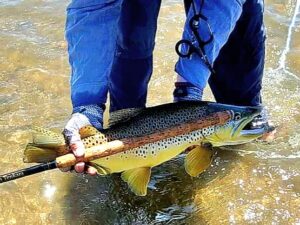
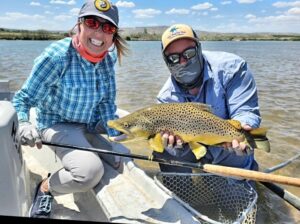
Big water though doesn’t necessarily mean big casts. In fact, real distance-casts are seldom required on float trips since guides and rowers work hard to line up their anglers to seams at practical casting distances. The guide maneuvers the boat into position, then cues you to cast. Often a roll or single overhead cast is all that’s required to reach these sweet spots.
Floating with a tenkara rod that’s 12ft to 15ft long, with a 15ft line, plus about 8ft of leader and tippet, you’ll have a total reach distance of 38ft—plenty for getting you comfortably into these sweet fishy zones. And while you can cast longer lines on a tenkara rod (about 40ft total line length plus your rod length), for most float trips, a 15ft line plus leader efficiently gets the job done. Remember, tenkara rods have no reel, so your casting distance remains set throughout the entire float. This consistency allows your guide to quickly become adept at knowing where to place the boat and put you into position.
When it comes to drift fishing and float trips, however, the key to success is the drift. Keeping your fly and line paced appropriately in the current for the purpose of creating and presenting a natural looking drift (or as we refer to it, a drag-free drift), is key to catching fish. “Insects”, or objects in the water that resemble tiny motorboats and move unnaturally, make fish leery to eat.
Anglers using a traditional rod and reel avoid or correct unnatural movement by mending. Positioning the fly and line in the current to create slack allows for a natural looking and drag-free drift. This aligning is accomplished by lifting your rod and line and flipping them in one direction or the other: up or down stream. This “mending” allows your line to keep pace with the current and repositions your surface fly or indicator, as well as any dropper flies, so they float freely. Interestingly, mending corrects for drag but can have some negative effects on presentation.
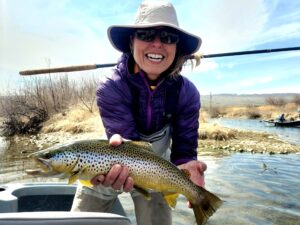
Each time you mend, a small disruption occurs at the site of the indicator or dry fly on the surface and any fly dropped beneath it. That mend, even for just a slight moment, changes the way your fly drifts in the current and can cause unnatural movement. Too many disruptions, and skittish fish can be wary of hitting your fly or suspicious of the way it’s drifting. Add to that disruption the different speeds at which the water is flowing at different levels in the water column, and the result is a drift and presentation that can cause hesitation and refusals by cautious fish. Mending is the classic case of, “damned if you do and damned if you don’t”.
Drift fishing with a traditional rod and reel means fly line is laying on the surface of the water. We must mend. It’s our only option at attempting an unhindered drift—even though the mending itself causes some disruption. But what if our line was not on the water? What if our line was held above it?
A long 15ft, fixed line tenkara rod paired with about a 15ft line allows the angler to reach out and drop their line straight down into seams. Nothing is on the surface of the water. All the line is held up and off the surface. Therefore, there is no drag, so there is no need for mending. No mending means no micro-disruptions, and it can also mean an indicator is more a preference than a need. Imagine, floating naked.
Tenkara rods are incredibly sensitive—much more so than a regular fly rod. Hollow and ultralight, they allow you to feel everything. The directly attached fixed line and tight setup mean that tactile feedback on a tenkara rod (that weighs only a few ounces), is so much greater than on a rod and reel. Nymphing indicator-less, or naked, becomes easier than you would think. Ditching the indicator also eliminates unnatural movements caused by the different flow speeds in the water column compared to the surface. No indicator. No drag. No mending. Nothing but carefree drifting.
Of course, you can use an indicator on a tenkara rod if you prefer. You’ll still achieve a drift better than on a rod and reel since you’re keeping line off the surface of the water and eliminating most of your drag. What’s more: you’re also significantly reducing shoulder irritation and fatigue. While you can imitate a “tenkara drift” by holding your traditional fly rod up high to try and produce a “straight down” presentation, doing this maneuver for a full day will get tiring and will wear your shoulder out.
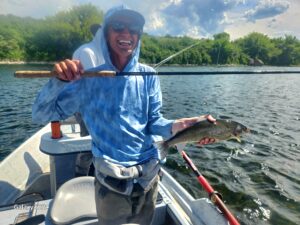
Landing is the next obvious concern when using a tenkara rod during a float trip. With no reel, allowing a fish to run on a tenkara rod is never an option. Fish play and management become essential, which are skills all anglers should acquire. Landing fish quickly and efficiently is critical in reducing fish mortality. Catching and releasing fish quickly also means you get to cast and catch again! Truly, landing fish on a tenkara rod, on a float trip, is no more difficult than landing fish on a tenkara rod while wading. In fact, I dare say it might be easier since you have the option, if you hook into a true monster, to follow the fish from the boat.
One final thought on tenkara float trips: make sure you’re using a tenkara rod capable and designed for the task. Not all tenkara rods have the necessary strength or backbone for drift boat fishing. Some tenkara rods are designed for small water and small fish. Other tenkara rods are powerful enough to be used for saltwater species, including bonefish, junior tarpon, and permit. Tenkara rods come in different lengths and flex profiles, and some have different “FRAE Ratings” – Fly Rod Approximate Equivalency ratings. Make sure to pick the right rod for your intended application. Doing a tenkara float means choosing a rod with strength, power, and enough backbone to give you control for head-on battles. Fishing with long rods, 12ft to 15ft in length, will give you an undeniable advantage while drifting.
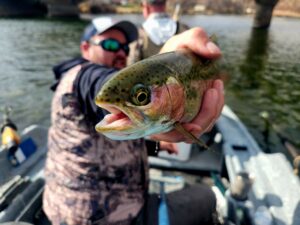
Next time you’re planning a float trip, consider using a tenkara rod. Kick up the excitement a full notch and experience some real, reel-less fun. Float drag-free. Heck, try floating naked. Feel every little tap and tick on your next float trip using an ultralight, ultralong tenkara rod for the best drift ever. Try drifting the river on tenkara.
Tight lines and happy fishing!



